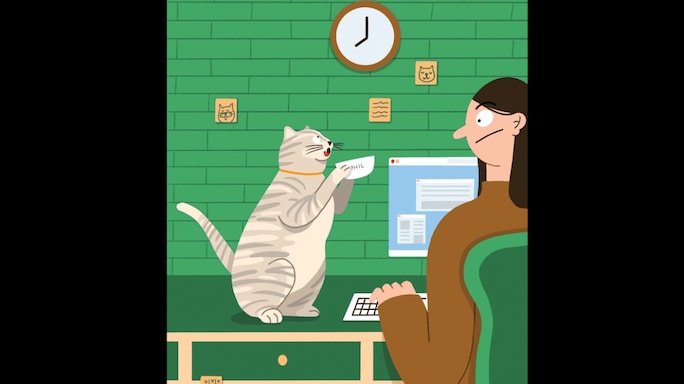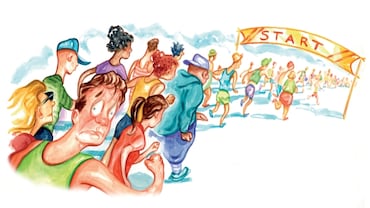The Trouble With Phil
My chubby feline needed to lose weight—if I could only convince him to try
 181 Reader’s Digest illustration by Diego Blanco
181 Reader’s Digest illustration by Diego Blanco
My cat Jean-Philippe is what you might charitably describe as ‘big-boned’. Actually, his head and tail are on the petite side. But then there’s his giant, jigglybelly. A year ago, he weighed in at nearly 11 kilograms. Now he’s a svelte 9.5 kilos, although our journey is far from over.
Depending on your age and cultural tastes, you might describe him as the feline Winston Churchill, or maybe the kitty Notorious B.I.G. I usually call him Fat Phil. I love him, but he is basically a meat loaf with fur. That makes him adorable, but not all that healthy.
To make sure that Phil would stick around for as long as possible, I knew I needed to make some changes to his diet—whether or not he was fully on board with them.
Not to make excuses for him, but let me tell you a little about Phil. I adopted him when he was about six months old. Before he came to my house, he had been living with a couple of other kittens in a sewer grate. The rescue group that found him told me he had kept himself alive by hunting lizards and eating generous handouts from a man who worked in a local bakery. From reptiles and stale bread, there was nowhere to go but up.
Like many formerly feral animals, Phil always tended to act as if he were starving to death. He wolfed down his cat food and meowed for more. In the beginning he was an indoor–outdoor cat and was getting plenty of exercise. Outdoor life can be hazardous for cats—they can be hit by cars, felled by disease and set upon by predators—but waistline expansion is not a major risk.
All of that changed when I moved Phil and his (non-feral, non-fat) adopted sister, Tufa, into a fourth-floor apartment in San Diego, California. He became a full-time indoor foodie. Before long, he was porkishly plump. In hindsight, maybe creating a pet paradise in my backyard would have been a good idea to ensure he got a little more exercise.
Since I am the Opener of the Cans, I can only blame myself. I’m a pushover. I felt sorry for him, deprived as he was of his lizard buffet. I also made the same mistake I’ve made when I’ve tried to shed a few kilos myself. Oh, how much could a little extra food hurt? I would think. I was clearly in denial.
I finally realized things were getting out of control when he outgrew his cat carrier and I was forced to buy one built for a medium-sized dog. His vet emphatically recommended a diet. Cats are vulnerable to many of the same health problems that obese humans are—and in fact, X-rays show that Phil already has some arthritis in his front paws. In his case, the stakes are even higher; he had a tumour removed from one of his back legs, and if it ever comes back, the recommendation is amputation. The vets say that tripod cats usually cope well with their disability, but not if they’re dragging around the equivalent of an additional cat.
Although Fat Phil needed to become Slim Phil, or at least Somewhat-Less-Chunky Phil, losing weight too quickly could be dangerous. Crash diets can cause a potentially fatal condition called hepatic lipidodis. Rather than slash Phil’s weight by half or more, the vet decided to aim for a more modest final weight of eight kilograms. That still means losing 25 per cent of his body weight. She sent me to a website that calculates how many calories a day a cat needs to consume to lose weight at a healthy pace. We were on our way.
This is when I learnt that you apparently need to understand advanced algebra to count cat-food calories.
Phil eats a combination of raw, freeze-dried, and canned food, and he began his diet at 270 calories a day. Have you ever tried to figure out the calories in your cat’s favourite brands of food? Some don’t include the information on the label. Others give it in teeny-tiny print.Or they publish it in terms that require you to figure out, say, that if 450 grams of freeze-dried chicken nuggets contain 125 calories, a kitchen cup weighs about 700 grams, and 50 nuggets fit in a cup, each nugget has … wait, carry the three ….
I have to keep reminding myself that this is the very best diet for cats, according to vets. And not surprisingly, a small food scale and a calculator are now fixtures in my cat-food cupboard. I also realized that there’s a huge disparity in how fattening different cat foods are. A small pouch of one of Phil’s favourite brands can range from less than 50 calories to more than 100. So, one of the first things I had to do was to find a happy medium of flavours that he liked, that would fill him up, and that would stay within his calorie count.
And hooray! After more than a year, Phil has lost one-and-a-half kilograms and his daily intake has been reduced to 250 calories. But it’s an ongoing struggle. He’s a hardened food thief. I feed his sister on a high bench-top that he can’t reach, but he regards the dining-room table as fair game. Just this morning, after chowing down his own breakfast, he sprinted off with a piece of my smoked salmon when I got distracted for a moment.
He wheedles And nags. He starts lobbying for dinner at about one p.m., sometimes rising up on his hind legs and tapping me on the shoulder with his front paw as I sit at my computer. If he had a watch, he’d be pointing at it. Resisting his pleas takes as much self-control as I can muster. But I persevere.And any month now, my boy is going to slim down that dog-sized body and become the size of a very large cat.






